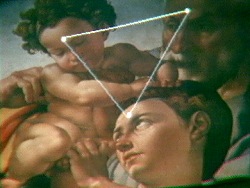Juan Downey
Biography
One of video's most original voices, Juan Downey produced a major body of work that interweaves a sophisticated multicultural discourse with an idiosyncratic search for identity. Merging the subjective and the cultural, the diaristic and the documentative, Downey investigated the self through the historical texts of Western art and culture, and the rituals of his native Latin America. Subverting documentary and narrative modes, his densely layered works are infused with rich intertextual analyses, associative pictorial metaphors and collage-like, nonlinear strategies.
A native of Chile who came to New York in 1965, Downey focused in his media work on two major series, Trans Americas and The Thinking Eye, in which he used video to define the self within cultural, political and economic systems. Mirrors, illusionism and the relativity of perception are invoked to question subjectivity, objectivity and the interactive relation between artist, viewer and subject, as he held cultures up to a "looking glass" to reflect the self.
Trans Americas, begun in 1971, is a series of tapes and installations that merge autobiography and anthropology in what Downey termed an attempt to "recuperate my culture" — a project that includes subjective visual records of his life among indigenous peoples of South America. Stated Downey, "I've been looking for my own self in South America." Less anthropological documents than personal odysseys, works such as The Laughing Alligator (1979) challenge the authoritative voice of ethnographic documentary. Downey posited encounters with otherness as metaphors for discovering his own cultural identity.
The Thinking Eye, subtitled Culture as an Instrument of Active Thought, is a series for public television that was Downey's attempt to "decipher the self through cultural obsessions. England, France, and Spain are my ancestors," he wrote. Complex interpretative systems of analysis — linguistic, psychoanalytic, art historical, semiotic — are applied to the intellectual, artistic and historical myths and traditions of Western culture. The title of the series, which includes Shifters (1984) and J.S. Bach (1986), refers both to the cognitive eye and the subjective "I."
From architecture to fashion shows, from Velasquez's Las Meninas to traffic signs, Downey's provocative deconstructions of Western art and cultural systems are filtered through subjective, often autobiographical associations. Exhibiting a virtuosic control of video technology, Downey articulates his analyses in a metaphorical visual language; sophisticated imaging devices fragment or conjoin images and sound to convey multiple layers of synesthetic meaning. In the interactive Bachdisc (1988), the nonlinear, labyrinthine structure of laserdisc technology forms an analogical parallel to the work's content, a Bach fugue, and Downey's own compositional strategies of deconstruction, metaphor and association.
In addition to his videotapes, Downey also produced an extensive body of work that included installations, drawings, and paintings.
Downey was born in Santiago, Chile in 1940 and died in 1993. He received a B.A. in Architecture from the Catholic University of Chile, and also studied at S.W. Hayter's Atelier 17 in Paris and the Pratt Institute in New York. Downey received numerous awards, including fellowships from the Guggenheim Foundation and the Rockefeller Foundation, as well as grants from the National Endowment for the Arts and the New York State Council on the Arts. He acted as associate professor in both the School of Architecture and the media department at Pratt Institute. His videotapes, drawings, performances and installations have been exhibited in solo shows at the Corcoran Gallery of Art, Washington D.C.; Whitney Museum of American Art, New York; Jewish Museum, New York; San Francisco Museum of Modern Art; Contemporary Art Museum, Houston; The Institute of Contemporary Art, Boston; International Center of Photography, New York; Schlessinger-Boissante Gallery, New York; El Museo del Barrio, New York; and IVAM Centre Julio Gonzalez, in Valencia, Spain. Downey's work has also been included in group exhibitions at The Museum of Modern Art, New York; Documenta 6, Kassel, West Germany; four Whitney Museum of American Art Biennial exhibitions, New York; Stedelijk Museum, Amsterdam; Venice Biennale; and the World Wide Video Festival, The Hague. In 1998 IVAM Centre Julio Gonzalez, in Valencia, Spain hosted a major retrospective of Downey's extensive body of work. Downey has had recent shows at the Bryce Wolkowitz and Nohra Haime Galleries in New York City, and was the focus of an exhibition, in 2006, at El Fundación Telefónica in Buenos Aires, Argentina.
